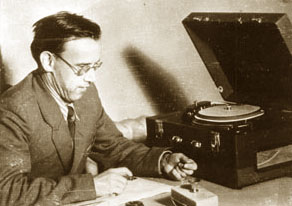Formation of the audio archive began in the early 1930's, when Karelian Research Institute (now - Institute of Linguistics, Literature and History, KRC RAS) - the first scientific institution in Karelia, was founded. The Institute included an ethno-linguistic section designed to study folklore and languages of the peoples living in Karelia.
The first gramophone records made on spent X-ray film are dated 1938-1941. Flexible gramophone records "on bones" carry a valuable collection of the north-Russian and Karelian folkloreuml epic songs, fairy-tales, lamentations, lyric songs, as well as compositions on the subjects related to the Soviet-time realities by tale-tellers ("tales" and "weepings"). Flexible gramophone records preserve the voices of the last generation of north-Russian tale-tellers P.I. Ryabinin-Andreev, P.G. Gorshkov, M.E. Samylin, N.V. Kigachev, F.A. Konashkov, M.M. Korgujev, I.T. Fofanov. Absolutely unique is the record of the famous epic song of the Ryabinins' tale-teller family narrated by Pjotr Ivanovich Ryabinin-Andreev ("Princes from Kraykov" - "Korolevichi iz Kryakova"). Still, only a very minor part of the materials has been brought out to the public so far.
Karelian folklore is not so well represented by the gramophone records: 5 rune-songs, 8 lamentations, 5 fairy-tales, 10 songs and 15 "weepings" with subjects related to Soviet realities (also in fragments). The largest number of recordings are performances by a well-known Karelian tale-teller A.F. Nikiforova from vil. Vohtozero. Other recordings are epic songs, fairy-tales and other compositions narrated by the tale-teller T.E. Turujev from middle Karelia; Karelian lamentations and songs by A.V. Vatchieva and M. Mikheeva. Other performers are represented by single recordings.
The recording on gramophone disks was carried out by A.D. Soimonov, K.F. Belova, V.Ya. Evseev, N.O. Bogdanov and other employees of the Karelian Research Institute.
The latest gramophone records are dated May 1941. During the World War II the gramophone recordings and other archival materials were evacuated. Not all of them returned as some were lost during the trip. What remained however is of enormous scientific and cultural value.
The aim of the creators of the collection was to preserve the live voices of the best Russian and Karelian folklore performers. The post-war years brought a new audio-recording tool - tape-recorders, which opened new opportunities for collectors.

Description of archive. Pre-war history
 Folklorist V.Ya. Evseev working with gramophone records. Late 1930's. |
 Karelian Research Institute building on the corner of the Pushkinskaya and Marx streets. Photo of 1932. |
| Rus |
Last modified: February 28, 2019 |